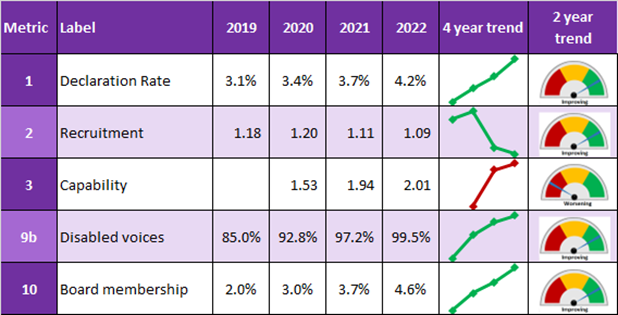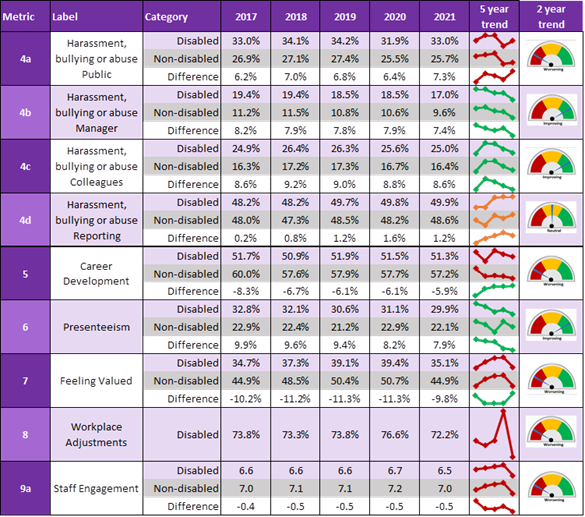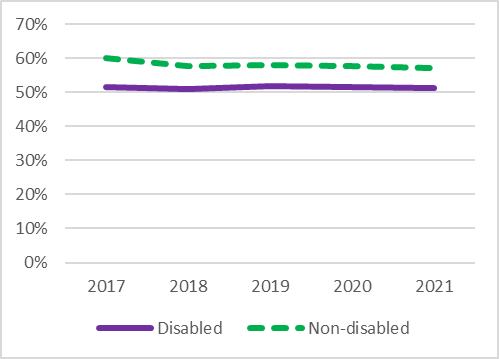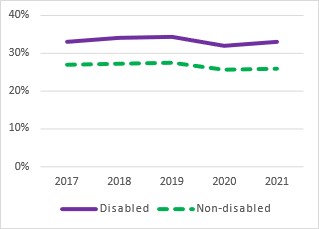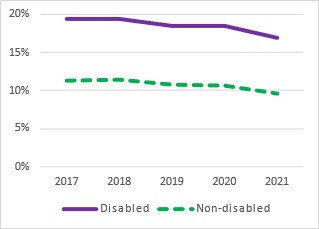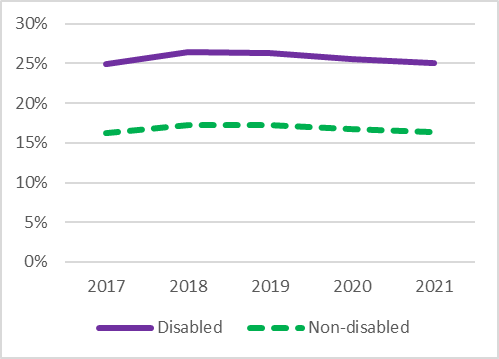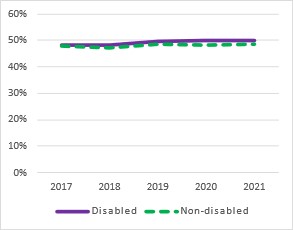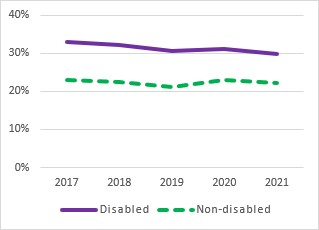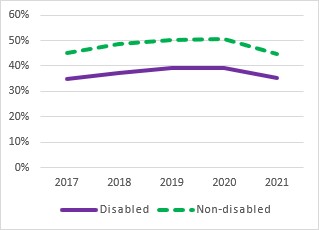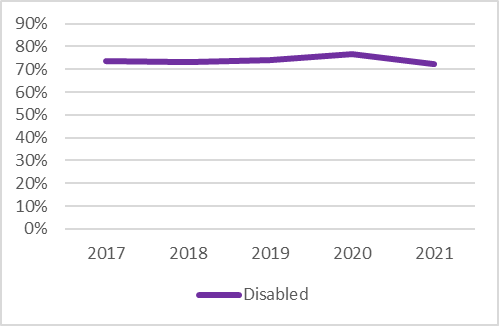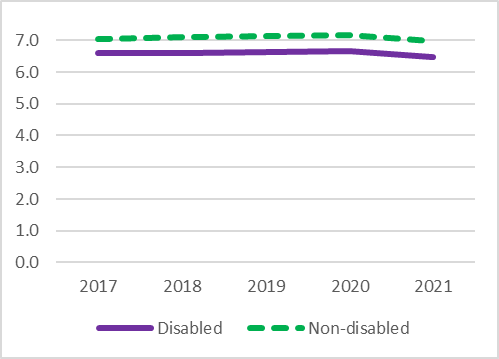Foreword
The People Promise sets out our aims to make the NHS an inclusive employer of choice. Bringing in talent and creating opportunities for all our people to develop their careers and realise their full potential are central tenets of the Messenger Review.
Disabled staff bring valuable lived experience and expertise of healthcare services and health conditions into the NHS workforce. Creating and sustaining the NHS as a disability inclusive employer brings multiple benefits across service delivery, including benefits for service users, patients and staff.
The number of disabled people in employment in the UK is increasing; UK Government figures show a year-on-year increase from 2.9 million people in 2013, to 4.4 million people in 2021 – an increase of 1.5 million over eight years. To ensure that we retain and support disabled staff in the workplace, and to support the NHS of the future, we must create and sustain an inclusive environment for them, where they can be themselves and realise their full potential. The recently published NHS EDI Improvement plan will drive and support this work.
The Workforce Disability Equality Standard (WDES) mandates NHS employers to report and publish annual data on the workplace and career experiences of disabled staff and is the only example of its kind in the UK. It has been designed to create a clear understanding of the collective experiences of disabled staff as employees, and to track change and progress year on year. It creates a dedicated focus on disability inclusion in the context of employment and a better knowledge of the evidence-based interventions that are having a positive impact.
The analysis of qualitative and quantitative data we present in this report shows that progress has been made across several of the WDES metrics. We continue to see year-on-year improvements in workforce representation, recruitment, Board membership and reducing presenteeism. However, the data also shows we need to re-double our efforts to improve experiences of harassment, career progression and reasonable adjustments.
We are committed to reducing the disparities that disabled staff experience and to improving the talent pipeline for disabled NHS staff.
Dr Navina Evans CBE, Chief Workforce, Training and Education Officer, NHS England
1. Introduction
This Workforce Disability Equality Standard (WDES) annual report is the fourth since the WDES was launched in 2019. It reports our analysis of the data collected from NHS trusts and foundation trusts in 2022 and gives a national picture of the collective career and workplace experiences of disabled NHS staff. The data shows that there has been progress over the four years of the WDES, but it also shines a light on those areas where disparities between disabled and non-disabled staff continue to exist.
This year for the first time, we have also analysed intersectional data drawn from the WDES metrics in the NHS Staff Survey and included our summary findings in this report. A review of intersectional data will support the implementation of the NHS EDI Improvement plan and provide insights into any future reviews of the mandated workforce standards.
To align the WDES with NHS priorities, this report has been structured under the themes of workforce supply and retention, rather than reviewing the metrics in numerical order. These priorities include working through the continuing challenges that are presented by the impact of the COVID-19 pandemic and current recovery, and the changing landscape that is being witnessed through closer integration of health and social care.
2. Key findings
Workforce representation
4.2% of the NHS workforce declared a disability through electronic staff records (ESR) in 2022, a modest increase of 0.5 percentage points since 2021. The number of people declaring a disability in the NHS Staff Survey has also increased, from 20.1% in 2020 to 23.2% in 2021.
Recruitment
The relative likelihood of a disabled job applicant being appointed through shortlisting has improved from 1.18 in 2019 to 1.09 in 2022.
Capability
The relative likelihood of a disabled colleague being in capability is 2.01. This means that disabled staff are twice as likely to be in the capability process on the grounds of performance.
Career progression
51.3% of disabled staff believed they had equal opportunities for career progression or promotion. This is a reduction from 51.9% in 2019.
Presenteeism
29.9% of disabled staff experienced presenteeism. We continue to observe improvements in this metric.
Staff engagement
The disabled staff engagement score was 6.5 (7.0 for non-disabled staff). 99.5% of trusts said that they had facilitated the voices of Disabled staff to be heard.
Harassment, bullying or abuse
33.0% of disabled staff reported having experienced bullying, harassment or abuse from patients, service users or the public, 17.0% from managers and 25.0% from other colleagues.
Workplace adjustments
72.2% of disabled staff reported they had the workplace adjustments required to perform their duties. This is a reduction from 76.6% in 2020.
Feeling valued
35.1% of disabled staff reported that they felt valued for their contribution. This is a reduction from 39.4% in 2020.
Board representation
4.6% of board members declared a disability through ESR in 2022, an increase of 0.9 percentage points since 2021.
3. Overview of metrics
Statement of metrics
Table 1 and Table 2 summarise the results for the 10 WDES metrics. The trend lines denote changes in the WDES metrics data since its inception as well as changes since the last WDES report. For some metrics, an upwards trajectory is positive (an improvement), while for others it represents a negative impact. For example, the upwards trend for metric 1 is an improvement, while for metric 3 it represents a worsening position.
|
Key |
Key description |
|
Red |
Declining position |
|
Amber |
Materially unchanged |
|
Green |
Improving position |
Table 1: WDES metrics based on 2022 Electronic Staff Record (ESR)* and HR/recruitment databases (4 year and 2 year trends). *ESR is the system used to record HR data in the NHS.
Table 2: WDES metrics based on 2021 NHS Staff Survey data (5 year and 2 year trends).
Sources of data
The metrics are derived from two data sources:
- Data provided directly by trusts. This data was collected in July and August 2022. As part of the NHS Standard Contract, trusts are required to provide data for metrics 1, 2, 3, 9b and 10. Data has been collected in this way for four years, creating consistency and allowing trends to be identified. In addition to submitting quantitative data, NHS organisations supply qualitative information which provides valuable context and insight into actions taken to improve equity for disabled staff.
- Data from the NHS Staff Survey. Every trust is required to participate in the annual NHS Staff Survey. Data from the relevant questions is used to calculate metrics 4, 5, 6, 7, 8 and 9a. The survey questions providing this data have been consistent since 2017 allowing a five-year trend to be reported. Results, both for individual organisations and national averages, can be accessed at www.nhsstaffsurveys.com. Data from latest survey available at the time of writing (2021) is used in this report.
This report provides analysis and insights into the quantitative and qualitative data collected from trusts as part of the NHS standard contract and the NHS staff survey.
4. Workforce supply
Under this heading we provide analysis for:
- Metric 1 – Workforce representation
- Metric 2 – Recruitment
- Metric 5 – Career progression
- Metric 10 – Board membership
4.1 Metric 1 – Workforce representation
Definition: Percentage of disabled staff in Agenda for Change (AfC)* bands 1 to 9, very senior manager (VSM) (including executive board members), medical/dental and other staff, compared with the percentage of non-disabled staff in these categories.
*AfC is the pay structure that covers clinical and non-clinical staff. It does not apply to medical or dental staff. Band 1 is the lowest band (although some data has been collected for staff on less than Band 1 rates, such as staff on apprenticeships) and band 9 is the highest on the main scale, with VSM and ESM bands higher still.
Headline: Overall declaration has increased from 3.0% in 2019 to 4.2% in 2022.
Table 3: Percentage disability declaration rates 2022
|
Total |
Non-clinical |
Clinical |
Medical/dental | |
|
Disabled |
4.2% |
4.9% |
4.3% |
1.7% |
|
Non-disabled |
76.7% |
76.1% |
77.6% |
72.4% |
|
Unknown |
19.1% |
19.0% |
18.1% |
25.9% |
-
Summary insight from data collections:
- As of 31 March 2022, 59,077 (4.2%) NHS staff members declared a disability on ESR which is an increase of 13.6% from 2021. However, this is significantly lower than the 23.2% of NHS staff who report a disability through the 2021 NHS Staff Survey. This is more reflective of the UK population where 21% have identified as disabled through Family Resources Survey: financial year 2020 to 2021 – GOV.UK
- At trust level, disability declaration rates vary from 1.6% to 12.2%.
- The disability declaration category ‘unknown’ encompasses ‘prefer not to answer’, ‘not declared’ and ‘unspecified’ and has reduced from 25.4% in 2019 to 19.1% in 2022.
- Three trusts have an unknown rate of over 50%.
- Declaration rates among medical/dental staff are particularly low in some trusts, especially among trainees. Twenty one trusts have an unknown rate of over 50% for this staff group, with some at 85%.
- Similarly, some trusts have high unknown rates for lower banded roles (AfC band 2 and below).
- The best performing trust in terms of unknown declarations has a rate of 1.8%: 12 trusts have a declaration rate of less than 5%.
- Disability declaration rates are lower for senior staff (staff at band 8c or above if on the AfC pay scale, or consultants on medical/dental pay scales) than for other pay bands:
- In 2022, the disability declaration rate for AfC band 8c and above was 3.1%, compared to 4.5% for AfC bands below 8c.
- In 2022, the disability declaration rate for consultants was 1.2%, compared to 2.1% for other medical/dental staff groups.
- Eight trusts (a reduction from 24 in 2019) have no disabled staff in AfC band 8c or above.
- Analysis showed that declaration rates improved where trusts had a dedicated workstream on promoting the ESR self service with a tailored ‘how to’ guide included in induction packs and available on the intranet, as well as strong internal communication activities and focus group workshops to promote the benefits of declaration.
The disparity between the disability declaration rates on ESR (4.2%) and the NHS Staff survey (23.2%) highlights a potential risk that approximately 327,067 staff with a disability are not having their needs addressed.
Key findings from intersectional data analysis on WDES metric 1:
- There is very little difference in the disability declaration rates between men and women: both are close to 23.5%.
- Disability declaration rates for lesbian and gay (37.5%), and bisexual (45.1%) staff are significantly higher than the rates for heterosexual/straight staff (22.2%).
- Disability declaration rate for staff from a White British background (26.2%) is higher than those for all other ethnicity groups, with the exception of staff from White and Black Caribbean backgrounds (27.5%) and White – Gypsy or Irish Traveller backgrounds (39.7%) (both of which are small groups numerically).
- Disability declaration rate for staff from an Asian background is particularly low (11.3%).
- Staff from a Black Caribbean background have a disability rate (21.8%) over twice that for staff from a Black African background (10.7%).
- Between the 2020 and 2021 staff surveys, the overall disability declaration rate increased by:
- 3.1 percentage points overall.
- 3.7 percentage points for staff from a White British background.
- 2.5 percentage points for staff from a Pakistani background.
- 1.6 percentage points for staff from an Indian background.
- Further analysis is required to understand the drivers of the variability in disability declaration rates across multiple protected characteristics.
4.3. Metric 2 – Recruitment
Definition: Relative likelihood of disabled applicants being appointed from shortlisting compared to non-disabled applicants.
Headline: On average across NHS trusts in England, the chance of a disabled candidate being appointed is not statistically significantly different (using the four-fifths rule) from that for a non-disabled candidate (Table 4) where 1 represents equity of opportunity.
Table 4 – Relative likelihood of disabled applicants being appointed from shortlisting compared to non-disabled applicants.
|
2019 |
2020 |
2021 |
2022 |
|
1.18 |
1.20 |
1.11 |
1.08 |
Summary insight from data collections:
- The relative likelihood of appointment for disabled people has improved from 1.18 in 2019 to 1.08 in 2022.
- No findings are statistically significant when the data is split by; trust type or size, region, Disability Confident rating or Care Quality Commission (CQC) ‘well led’ domain.
- Relative likelihoods vary between trusts from 0.37 (disabled interviewees are 2.7 times more likely to be appointed than non-disabled interviewees) to 8.23 (non-disabled interviewees are eight times more likely to be appointed than disabled interviewees).
- The number of trusts with a relative likelihood of more than 1.25 is falling, suggesting non-disabled interviewees are statistically more likely to be appointed than disabled interviewees.
- An analysis of the qualitative data collected suggests that developing external communications to encourage disabled applicants increased the relative likelihood of a disabled person being appointed. Seventy-nine trusts indicated that accepting applications in alternative formats has had a positive impact on the recruitment of disabled staff. We strongly advocate that all trusts should make this explicit in all recruitment processes and communications.
Table 5 shows that trusts which statistically favour non-disabled applicants have a lower disability declaration rate than other trusts. Their number is reducing year on year.
Table 5 – Trusts with statistically significant adverse recruitment for disabled staff.
|
2020 |
2021 |
2022 | ||
|
Trusts that statistically favour non-disabled applicants |
Number |
103 |
86 |
60 |
|
Disability declaration rate |
3.3% |
3.5% |
3.8% | |
|
All other trusts |
Number |
119 |
131 |
153 |
|
Disability declaration rate |
3.6% |
3.9% |
4.4% |
While the statistical test suggests that on average, recruitment practices are fair for disabled applicants, the results for individual trusts vary considerably, with some trusts more than eight times more likely to appoint non-disabled applicants than disabled applicants. Additionally, many disabled staff do not declare a disability during the recruitment process, suggesting that a continued focus is needed on creating inclusive cultures that give disabled people confidence in declaring a disability at the application stage.
Furthermore, high impact action two in the NHS EDI improvement plan, requires organisations to ‘Embed fair and inclusive recruitment processes and talent management strategies that target under-representation and lack of diversity’.
4.3 Metric 5 – Career progression
Definition: Percentage of disabled staff compared to non-disabled staff believing their trust provides equal opportunities for career progression or promotion.
Headline: Just over half of disabled staff believe their organisation treats everyone equally regarding career progression or promotion (Table 6 and Figure 1).
Table 6 and Figure 1 show that around 50% of disabled staff believe that there are equal opportunities for career progression and this proportion has not materially changed over the last five years. The difference between disabled and non-disabled staff who believe their trust provides equal opportunity has slowly reduced over this timeframe and is now 5.9 percentage points.
Table 6 – Percentage of disabled and non-disabled staff who believe their trust provides equal opportunities for career progression or promotion.
|
Year |
Disabled |
Non-disabled |
Difference (disabled from non-disabled) |
|
2017 |
51.7% |
60.0% |
-8.3 percentage points |
|
2018 |
50.9% |
57.6% |
-6.7 percentage points |
|
2019 |
51.9% |
57.9% |
-6.1 percentage points |
|
2020 |
51.5% |
57.7% |
-6.1 percentage points |
|
2021 |
51.3% |
57.2% |
-5.9 percentage points |
Figure 1: Percentage of disabled and non-disabled staff who believe their trust provides equal opportunities for career progression or promotion.
Across trusts, the percentage of disabled staff believing they have equal opportunities for career progression or promotion ranges from 67.4% (best) to 27.7% (worst).
Key findings from intersectional data analysis:
- Disabled female staff (53.0%) are more likely than disabled male staff (46.5%) to say that their organisation provides equal opportunities for career
- Disabled staff who prefer not to define their gender have much lower rates (26.1%) than disabled males or disabled females.
- The NHS Staff Survey reports on ethnic background in two ways: detailed (which contains 18 different options) and summary (which combines the individual responses into 7 categories). Looking at both of these in relation to disability can provide different insights:
- In the summary analysis, of the seven ethnic background groups, Asian staff have the widest gap between disabled and non-disabled staff in relation to opportunities for career progression (10.8 percentage points).
- In the detailed analysis, of the 18 ethnic background groups, staff from a White – Gypsy or Irish Traveller background have the widest gap between disabled and non-disabled staff (12.0 percentage points).
4.4 Metric 10 – Board representation
Definition: percentage of the board’s membership who have declared a disability.
Headline: Table 7 below shows that the disability declaration rate among board members is now 4.6%, 0.4 percentage points higher than it is for the overall workforce.
Table 7 – 2022 Board membership
|
2022 Board membership |
Overall workforce | |||||
|
Total |
Voting |
Non-voting |
Exec |
Non-exec | ||
|
Disabled |
4.6% |
4.8% |
3.9% |
4.2% |
5.0% |
4.2% |
|
Non-disabled |
74.1% |
73.4% |
76.4% |
79.2% |
69.0% |
76.7% |
|
Unknown |
21.4% |
21.9% |
19.7% |
16.6% |
26.0% |
19.1% |
Summary insight from data collections:
- 152 board members have declared a disability, a rise of 30 since 2019.
- The declaration rate of board members is now higher than the overall workforce, having risen from 3.7% in 2021 to 4.6% in 2022.
- The highest board declaration rate is 38.5%: this is the only trust with a declaration rate above that from the NHS Staff Survey (23.2%).
- Just over half of boards (50.7%) have at least one disabled member, and 16.6% have more than one (this has risen from 3.9% in 2019).
- Non-executive directors have the highest proportion of disabled staff (5%; up from 3.6% in 2021), but also the highest proportion of ‘unknown’.
- 2% of executive board members have declared a disability (up from 3.8% in 2021).
- Disabled board members make up 4.8% of the voting members of boards (up from 3.8% in 2021). The disability declaration rate for non-voting members is 3.9%, which is unchanged from 2021.
- ‘Unknown’ status is higher among board members at 21.4% compared with the rate for the overall workforce (19.1%).
- In one trust, the disability status for all board members is ‘Unknown’.
5. Retention
Under this heading we provide analysis for:
- Metric 3 – Capability.
- Metric 4 – Harassment, bullying or abuse.
- Metric 6 – Presenteeism.
- Metric 7 – Feeling valued.
- Metric 8 – Workplace adjustments.
- Metric 9 – Staff engagement.
5.1 Metric 3 – Capability
Definition: Relative likelihood of disabled staff compared to non-disabled staff entering the formal capability process on the grounds of performance
Headline: Disabled staff are twice as likely as non-disabled staff to enter the formal capability process on the grounds of performance (Table 8).
Table 8 – Relative likelihood of disabled staff compared to non-disabled staff entering the formal capability process on the grounds of performance.
|
2019* |
2020 |
2021 |
2022 |
|
|
1.53 |
1.94 |
2.01 |
*Provision of this data in 2019 was voluntary and so the results obtained are not considered representative.
The data reported has changed since the WDES was launched in 2019, in part because the metric covers capability on the grounds of performance (not ill-health) but earlier datasets may have included both. As the dataset covers a two-year period, the 2022 figure (covering the period April 2020 to March 2022) carries data confidence.
7.5% of staff in the capability process have declared themselves to be disabled (compared to 4.2% of the total workforce).
The number of cases overall and in some trusts is very small, and we therefore:
- have not disaggregated the data further.
- advise that drawing any conclusions at trust or regional level should be done with care.
Trusts with a higher relative likelihood (above 1.25) should undertake further investigations to identify possible causes, bearing in mind that low numbers (fewer than 10 disabled staff entering the capability process on the grounds of capability) are unlikely to be evidence of institutional issues and do not need to be reported.
5.2 Metric 4 – Harassment, bullying or abuse
This metric is split into four parts:
- Metric 4a – Harassment, bullying or abuse from patients, service users, their relatives or other members of the public.
- Metric 4b – Harassment, bullying or abuse from managers.
- Metric 4c – Harassment, bullying or abuse from other colleagues.
- Metric 4d – Percentage of staff who reported harassment, bullying or abuse the last time it happened.
5.2.1 Metric 4a – Harassment, bullying or abuse from patients, service users, their relatives or other members of the public
Definition: Percentage of disabled staff compared to non-disabled staff experiencing harassment, bullying or abuse in the last 12 months from patients, service users, relatives or members of the public.
Headline: One in three disabled staff experience harassment, bullying or abuse from patients, service users, their relatives, or members of the public (Table 9 and Figure 2).
Table 9 and Figure 2 show that a third of disabled staff (33.0%) report that they have experienced bullying, harassment or abuse from patients, service users or the public. Levels are six to seven percentage points higher than for non-disabled staff, a difference that has remained relatively constant over the last five years.
In 2020, when the previous NHS Staff Survey was undertaken, the pandemic limited the number of face-to-face appointments in many areas, significantly reducing the number of times negative interactions could occur. This is reflected in a significant drop (improvement) in this metric. In 2021, with an easing of COVID-19 related restrictions, the number of face-to-face appointments increased and so did the level of harassment (Table 9).
Table 9: Proportion of disabled and non-disabled staff experiencing harassment, bullying or abuse from patients, service users or the public.
|
Year |
Disabled |
Non-disabled |
Difference (disabled from non-disabled) |
|
2017 |
33.0% |
26.9% |
+6.2 percentage points |
|
2018 |
34.1% |
27.1% |
+7.0 percentage points |
|
2019 |
34.2% |
27.4% |
+6.8 percentage points |
|
2020 |
31.9% |
25.5% |
+6.4 percentage points |
|
2021 |
33.0% |
25.7% |
+7.3 percentage points |
Figure 2: Proportion of disabled and non-disabled staff experiencing harassment, bullying or abuse from patients, service users or the public.
Across trusts, the proportion of disabled staff who experience harassment, bullying or abuse from patients, service users or the public varies from 16.0% (the best) to 63.0% (the worst), and there is a strong correlation with trust type. Around one in four disabled staff in community trusts experience harassment, bullying or abuse from patients: harassment, bullying or abuse in acute and mental health trusts is about five percentage points worse and in ambulance trusts about 20 percentage points worse still.
Between 2017 and 2020, the gap between the proportions of disabled staff and non-disabled staff experiencing harassment, bullying or abuse from patients, service users or the public had been slowly reducing. However, in 2021, this widened to 7.3 percentage points, the biggest gap in the last five years.
Summary insights from data collections:
- Peer support schemes improved the proportion of disabled and non-disabled staff experiencing harassment, bullying or abuse from patients, service users or the public metric by +0.30 percentage points.
- Trusts that utilised Dignity at Work campaigning, disability awareness campaigns and the NHS Civility and Respect toolkit saw improvements in this metric. The qualitative analysis highlights that trusts who triangulated data collected on this metric from the staff survey with that held by staff-side representatives, exit interviews and grievance records, and addressed any findings, showed an improvement in their staff experience in bullying, harassment or abuse from patients/public/service user and relatives.
- Levels of harassment, bullying or abuse from patients/public/service users in trusts not taking any of these actions performed less well and were 0.81 percentage points above the national average.
Key findings from intersectional data analysis:
- Rates are considerably higher for staff who prefer to self-describe their gender (42.0% for disabled staff) than for males (31.6% for disabled staff) and females (33.2% for disabled staff).
5.2.2 Metric 4b – Harassment, bullying or abuse from managers
Definition: Percentage of disabled staff compared to non-disabled staff experiencing harassment, bullying or abuse in the last 12 months from managers.
Headline: 17.0% of disabled staff and 9.6% of non-disabled staff report experiencing harassment, bullying or abuse from managers (Table 10 and Figure 3).
Table 10 and Figure 3 below show that around a fifth of disabled staff say that they have experienced harassment, bullying or abuse from their managers. The difference between disabled and non-disabled staff is slowly reducing but remains 7.4 percentage points higher for disabled staff in 2021.
Table 10: Proportion of disabled and non-disabled staff experiencing harassment, bullying or abuse from managers.
|
Year |
Disabled |
Non-disabled |
Difference (disabled from non-disabled) |
|
2017 |
19.4% |
11.2% |
+8.2 percentage points |
|
2018 |
19.4% |
11.5% |
+7.9 percentage points |
|
2019 |
18.5% |
10.8% |
+7.8 percentage points |
|
2020 |
18.5% |
10.6% |
+7.9 percentage points |
|
2021 |
17.0% |
9.6% |
+7.4 percentage points |
Figure 3: Proportion of disabled and non-disabled staff experiencing harassment, bullying or abuse from managers.
The proportion of disabled staff who experience harassment, bullying or abuse from managers varies in NHS trusts from 7.3% (the best) to 32.8% (the worst).
Summary insight from data collections:
- Dedicated champions / ambassadors / advisors within trusts for tackling bullying and harassment improved the metric for the proportion of disabled staff who experience harassment, bullying or abuse from managers.
- Trusts that compared data from the staff survey with other data sources such as grievance data and health and wellbeing data, were able to act upon the findings and record an improvement in this metric.
Key findings from intersectional data analysis:
- Disabled female staff report lower rates of harassment, bullying or abuse (16.3%) compared to their male counterparts (19.1%).
- Disabled staff who prefer not to disclose their gender report higher rates (31.0%) compared to all other groups.
- Disabled lesbian and gay staff report higher rates (19.5%) than heterosexual/straight disabled staff (16.4%).
- Rates are higher for disabled staff with the following ethnic backgrounds: Bangladeshi, White and Black African, Arab and White – Gypsy or Irish Traveller.
5.2.3 Metric 4c – Harassment, bullying or abuse from other colleagues
Definition: Percentage of disabled staff compared to non-disabled staff experiencing harassment, bullying or abuse in the last 12 months from other colleagues.
Headline: One in four disabled staff experience harassment, bullying or abuse from colleagues. This is 8.6 percentage points higher than for non-disabled staff (Table 11 and Figure 4).
Table 11: Proportion of disabled and non-disabled staff experiencing harassment, bullying or abuse from other colleagues.
|
Year |
Disabled |
Non-disabled |
Difference (disabled from non-disabled) |
|
2017 |
24.9% |
16.3% |
+8.6 percentage points |
|
2018 |
26.4% |
17.2% |
+9.2 percentage points |
|
2019 |
26.3% |
17.3% |
+9.0 percentage points |
|
2020 |
25.6% |
16.7% |
+8.8 percentage points |
|
2021 |
25.0% |
16.4% |
+8.6 percentage points |
Figure 4: Proportion of disabled and non-disabled staff experiencing harassment, bullying or abuse from other colleagues.
In trusts, the proportion of disabled staff who experience harassment, bullying or abuse from other colleagues varies from 12.8% (the best) to 36.2% (the worst).
Key findings from intersectional data analysis:
- Heterosexual/straight disabled staff experience the lowest levels of harassment from other colleagues; about 5 percentage points lower than for all other sexual orientation
- The rate for disabled staff from a Black ethnic background (includes staff from a Black African, Black Caribbean and any other Black background) increased considerably, from 29.5% in 2020 to 31.7% in 2021.
Addressing harassment, bullying and abuse is one of the six high impact actions within the NHS England EDI improvement plan ‘Create an environment that eliminates the conditions in which bullying, discrimination, harassment and physical violence at work occur.’
5.2.4 Metric 4d – Reporting harassment, bullying or abuse
Definition: Percentage of staff who reported harassment, bullying or abuse the last time it happened.
Headline: Nearly half of disabled staff reported the latest incidence of harassment, bullying or abuse (Table 12 and Figure 5).
Overall, more disabled staff are reporting bullying, harassment or abuse.
Table 12 shows that the gap is widening between the experiences of disabled and non-disabled staff, from 0.2 percentage points in 2017 to 1.2 percentage points in 2021. The data also shows that only around 50% of disabled and non-disabled staff report incidents of bullying, harassment, or abuse.
Trusts should continue to take action to reduce the levels of harassment, bullying and abuse experienced by staff, as well as provide supportive services to allow incidents to be reported and actions taken in response.
Table 12: Percentage of disabled and non-disabled staff who reported harassment, bullying or abuse the last time it happened.
|
Year |
Disabled |
Non-disabled |
Difference (disabled from non-disabled) |
|
2017 |
48.2% |
48.0% |
+0.2 percentage points |
|
2018 |
48.2% |
47.3% |
+0.8 percentage points |
|
2019 |
49.7% |
48.5% |
+1.2 percentage points |
|
2020 |
49.8% |
48.2% |
+1.6 percentage points |
|
2021 |
49.9% |
48.6% |
+1.2 percentage points |
Figure 5: Percentage of disabled and non-disabled staff who reported the last incidence of harassment, bullying or abuse.
Across trusts the proportion of disabled staff who reported the latest incidence of harassment, bullying or abuse varies from 75.0% (the best) to 34.4% (the worst).
Summary insight from data collections:
- Comparing data on reporting the last incidence of harassment, bullying or abuse with data held by health and wellbeing leads gave an uplift in the metric of + 0.12 percentage points.
Key findings from intersectional data analysis:
- Disabled females are more likely to report harassment, bullying or abuse (51.0%) compared to males (45.1%).
- Staff from a Black background are more likely to report harassment, bullying or abuse (56.0%) than staff from any other ethnic background (47.5% to 50.7%).
5.3 Metric 6 – Presenteeism
Definition: Percentage of disabled staff compared to non-disabled staff saying that they have felt pressure from their manager to come to work, despite not feeling well enough to perform their duties.
Headline: Just under 30% of disabled staff experience presenteeism; this is the lowest level for five years (Table 13 and Figure 6).
Table 13 and Figure 6 show that there are significantly higher rates of presenteeism amongst disabled staff – around a third of disabled staff answer ‘yes’ to this question. The difference in this metric between disabled and non-disabled staff is significant but has fallen from 9.9 percentage points in 2017 to 7.9 percentages points in 2021.
Table 13: Percentage of disabled and non-disabled staff saying that they have felt pressure from their manager to come to work, despite not feeling well enough to perform their duties.
|
Year |
Disabled |
Non-disabled |
Difference (disabled from non-disabled) |
|
2017 |
32.8% |
22.9% |
+9.9 percentage points |
|
2018 |
32.1% |
22.4% |
+9.6 percentage points |
|
2019 |
30.6% |
21.2% |
+9.4 percentage points |
|
2020 |
31.1% |
22.9% |
+8.2 percentage points |
|
2021 |
29.9% |
22.1% |
+7.9 percentage points |
Figure 6: Percentage of disabled and non-disabled staff saying that they have felt pressure from their manager to come to work, despite not feeling well enough to perform their duties.
Across trusts, the proportion of disabled staff saying that they have felt pressure from their manager to come to work despite not feeling well enough to perform their duties ranges from 10.7% (best) to 64.6% (worst).
Ten trusts have a presenteeism rate for disabled staff of over 40%. Analysis of the qualitative data suggests that self-management training and training for managers helped improve this metric.
5.4 Metric 7 – Feeling valued
Definition: Percentage of disabled staff compared to non-disabled staff saying that they are satisfied with the extent to which their organisation values their work.
Headline: The proportion of disabled staff who feel valued by their employer fell 4.3 percentage points, from 39.4% in 2020 to 35.1% in 2021 (Table 14 and Figure 7).
Table 14 and Figure 7 show that around a third of disabled staff (35.1%) say that they are satisfied with the extent to which their organisation values their work. This compares with around 45% for non-disabled staff. This measure has dropped significantly for all staff, but more for disabled staff (1.2 percentage points compared to 0.8 percentage points for
non-disabled staff).
Table 14: Percentage of disabled and non-disabled staff saying that they are satisfied with the extent to which their organisation values their work.
|
Year |
Disabled |
Non-disabled |
Difference (disabled from non-disabled) |
|
2017 |
34.7% |
44.9% |
-10.2 percentage points |
|
2018 |
37.3% |
48.5% |
-11.2 percentage points |
|
2019 |
39.1% |
50.4% |
-11.3 percentage points |
|
2020 |
39.4% |
50.7% |
-11.3 percentage points |
|
2021 |
35.1% |
44.9% |
-9.8 percentage points |
Figure 7: Percentage of disabled and non-disabled staff saying that they are satisfied with the extent to which their organisation values their work.
Across trusts, the percentage of disabled staff saying that they are satisfied with the extent to which their organisation values their work ranges from 54.6% (best) to 15.9% (worst).
5.5 Metric 8 – Workplace adjustments
Definition: Percentage of disabled staff saying that their employer has made adequate adjustment(s) to enable them to carry out their work.
Headline: The proportion of disabled staff who obtained the workplace adjustments they need to perform their work effectively dropped by 4.4 percentage points, from 76.6% in 2020 to 72.2% in 2021 (Table 15 and Figure 8).
Table 15 and Figure 8 below show that around three quarters of disabled staff (73.8%) are satisfied with their workplace adjustments. This improved in 2020, but then reduced in 2021 to 72.2%.
Table 15: Percentage of disabled staff saying that their employer has made adequate adjustment(s) to enable them to carry out their work.
|
Year |
Disabled |
|
2017 |
73.8% |
|
2018 |
73.3% |
|
2019 |
73.8% |
|
2020 |
76.6% |
|
2021 |
72.2% |
Figure 8: Percentage of disabled staff saying that their employer has made adequate adjustment(s) to enable them to carry out their work.
Across trusts the percentage of disabled staff saying that their employer has made workplace adjustment(s) (following feedback, the wording for the NHS Staff Survey 2022 will be changed to ‘reasonable adjustments’) to enable them to carry out their work ranges from 89.5% (best) to 48.1% (worst). Seven trusts have a rate of less than 60%.
The national average for the proportion of disabled staff who have received the workplace adjustments they need fell from 76.6% in 2020 to 72.2% in 2021.
Summary insight from data collections:
- Trusts that have a reasonable adjustments policy have a 1.0 percentage point higher rate of providing workplace adjustments than trusts that do not.
- Trusts that fund workplace adjustments from central budgets saw a smaller drop on this metric (3.7 percentage points) from 2020 to 2021 than the national average (4.6 percentage points) which provides support for a centralised approach to reasonable adjustments budgets as this can enable greater consistency in how adjustments are provided.
- The provision of a disability/workplace adjustments passport was one of the key drivers of improved disability declaration rates in the staff survey.
5.6 Metric 9a – Staff engagement
Definition: The staff engagement score for disabled staff from the NHS Staff Survey, compared to non-disabled staff.
Headline: The staff engagement score for disabled staff in 2021 was 6.5 which is 0.5 points lower than that for non-disabled staff (Table 16 and Figure 9).
Table 16 and Figure 9 show that engagement with disabled staff improved in 2020, but in 2021 reduced by a statistically significant margin, as it has done for non-disabled staff. The difference between disabled and non-disabled staff has largely not changed over the last five years.
Table 16: Staff engagement score.
|
Year |
Disabled |
Non-disabled |
Difference (disabled from non-disabled) |
|
2017 |
6.6 |
7.0 |
-0.4 |
|
2018 |
6.6 |
7.1 |
-0.5 |
|
2019 |
6.6 |
7.1 |
-0.5 |
|
2020 |
6.7 |
7.2 |
-0.5 |
|
2021 |
6.5 |
7.0 |
-0.5 |
Figure 9: Staff engagement score.
Across trusts, the staff engagement score for disabled staff ranges from 7.18 (best) to 4.95 (worst).
Definition: has your trust taken action to facilitate the voices of disabled staff in your organisation to be heard?
5.7 Metric 9b – Voices of disabled staff
Headline: In 2022, only one trust declared that they had not taken action to facilitate the voices of disabled staff to be heard. This has reduced from 34 in 2019.
Summary insight from data collections:
Trusts report on actions they have taken to facilitate the voices of disabled staff that include,
- Disabled staff networks that have sub-networks for groups such as neurodivergence, those with mental health issues and non-visible disabilities
- Disabled staff networks that include executive sponsors.
- Disabled staff network chairs being invited to board meetings or regular meetings with the trust chair.
- The introduction of staff mentor partnerships schemes.
- The development of a disability inclusion toolkit.
- Organising Annual Disability conferences.
6. Additional information
6.1. Disability data on ESR
Questions are frequently asked about the prevalence of the different types of disability in the NHS workforce. ESR allows staff to record their disability status by choosing from a list of options that is extensively used across government departments. Table 17 gives a breakdown of this ESR data for trusts in England (the effective date and validation process used for this data vary slightly from those used in the main WDES data collection. This produces results slightly different from those reported for metric 1).
Table 17: Disability categorisation over time.
| April 2018 | April 2022 | Difference | |
|
Learning disability/difficulty |
25.0% |
28.9% |
+3.9 percentage points |
|
Long-standing illness |
27.3% |
26.9% |
-0.4 percentage points |
|
Mental health condition |
11.1% |
11.8% |
+0.8 percentage points |
|
Physical impairment |
14.7% |
12.5% |
-2.2 percentage points |
|
Sensory impairment |
12.2% |
11.0% |
-1.2 percentage points |
|
Prefer not to answer |
9.8% |
8.9% |
-0.9 percentage points |
The data provided does not currently allow this national result to be broken down into any groups (e.g., trust, region, occupation group, pay band, etc.) but it is hoped this will be possible in time. Work to develop the Unified Information Standard for Protected Characteristics is ongoing, which will include a review of the disability categories. It is hoped this will result in options which allow more people to identify a long-term health condition or disability, thus improving the reliability and quality of our data.
The disparity in disability declaration rates between ESR (4.2%) and the NHS staff survey (23.2%) highlights the need for additional analysis on the staff survey disability declaration data. Applying the categorisation in ESR data to the disability declaration rate from the NHS Staff Survey gives the following estimates of disabled staff numbers by category across trusts in England as indicated in Table 18.
Table 18 – Estimated number of disabled staff by category.
|
March 2022 | |
|
Learning disability/difficulty |
81,805 |
|
Long-standing illness |
89,161 |
|
Mental health condition |
36,203 |
|
Physical impairment |
47,925 |
|
Sensory impairment |
39,997 |
|
Prefer not to answer |
31,976 |
|
Total |
327,067 |
Data for disability declaration by age is also available as indicated in Table 19.
Table 19 – Disability declaration rate by age.
|
Age Group |
April 2022 |
|
Under 30 |
5.5% |
|
30-34 |
4.7% |
|
35-39 |
4.5% |
|
40-44 |
4.3% |
|
45-49 |
4.3% |
|
50-54 |
4.6% |
|
55-59 |
4.6% |
|
60-64 |
4.4% |
|
65 and over |
3.8% |
|
Total |
4.6% |
Younger staff (who may be predominantly new entrants into the NHS) are more likely to declare a disability than older staff. Only 3.8% of staff in the oldest age category have declared a disability, compared to 42% of the UK’s state pension age adults (UK disability statistics: Prevalence and life experiences – House of Commons Library).
Appendix 1 – Data methodology and notes
In 2022, trusts were required to:
- verify, complete and submit data by 31 August 2021 via an online data collection portal.
- publish a board ratified WDES 2022/23 annual report, which should contain the trust’s metrics data, evidence of engagement with disabled staff and an action plan, on the trust’s external website by 31 October 2022.
For a detailed description of the metrics, and other associated information, please refer to the relevant guidance published on our website NHS England » Workforce Disability Equality Standard.
For WDES metrics 2 (Recruitment) and 3 (Capability), statistical significance is assessed using the ‘four-fifths’ rule. If the relative likelihood of an outcome for one subgroup compared to another is less than 0.80 or higher than 1.25, then the process would be identified as having an adverse impact: relative likelihoods between 0.8 and 1.25 suggest there is no significant difference between the subgroups. A lack of statistical significance should not be interpreted as meaning that disabled individuals or disabled staff do not experience inequalities in these areas.
Please note, the numbers quoted in this report may have been rounded, and as such some calculations may appear incorrect (especially those quoting the difference between percentages).
Comparisons to other NHS organisations for these metrics are available on the Model Health System.
Additional notes
- Data collected from trusts is either as a snapshot as at 31 March 2022 (metrics 1 and 10), the year running to 31 March 2022 (metrics 2 and 9b) or the average (mean) of the two years to 31 March 2022 (metric 3).
- Submission of data for metric 3 data (Capability) was only voluntary in 2019, and therefore this data is not considered representative of all trusts.
- NHS Staff Surveys are titled by the year in which the data was collected. At the time of writing this report, the latest available survey is from 2021 (the results of which were reported in March 2022).
- In metric 8, the terms ‘workplace adjustments’, ‘reasonable adjustments’ and ‘required adjustments’ are considered interchangeable.
- Up until 2021, both the WDES and the WRES allowed trusts to choose whether or not to include bank staff in their workforce figures for WDES metric 1 (indicator 1 in the WRES). In 2022, the WRES team introduced a separate data collection, analysis and report of bank staff, so have asked trusts not to include this group in their normal returns. Although the WDES team have not undertaken a survey of bank staff, many trusts have chosen to also remove this group from the WDES figures to ensure consistency with the WRES. From 2023, the WDES team will ask all trusts to remove bank staff from the standard return.
- Where improvements in metrics are reported with various factors considered and applied, these have all been tested and are shown to be statistically significant.
- Data in this report is frequently displayed in tabular, graphical and text formats to maximise accessibility.


